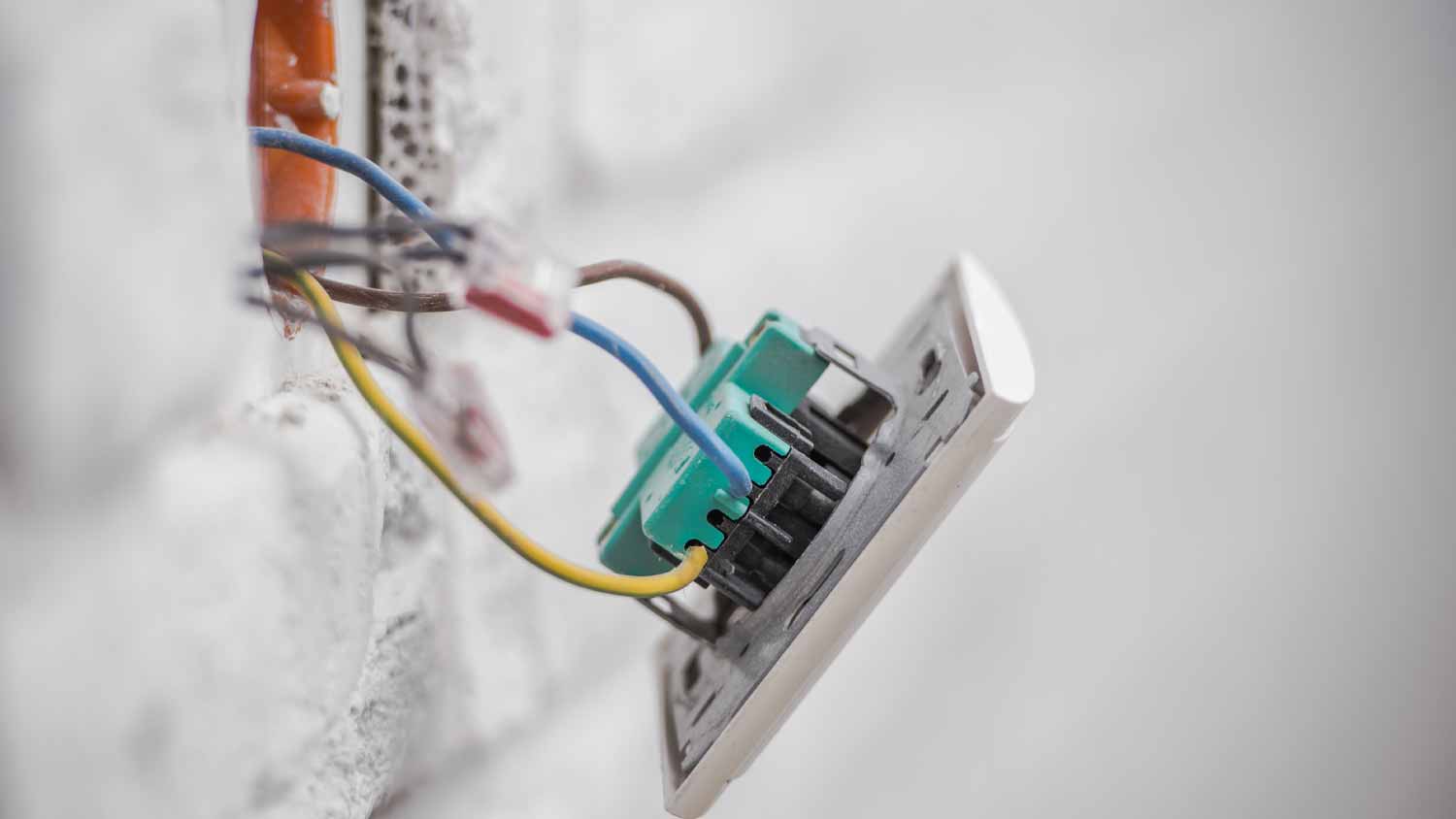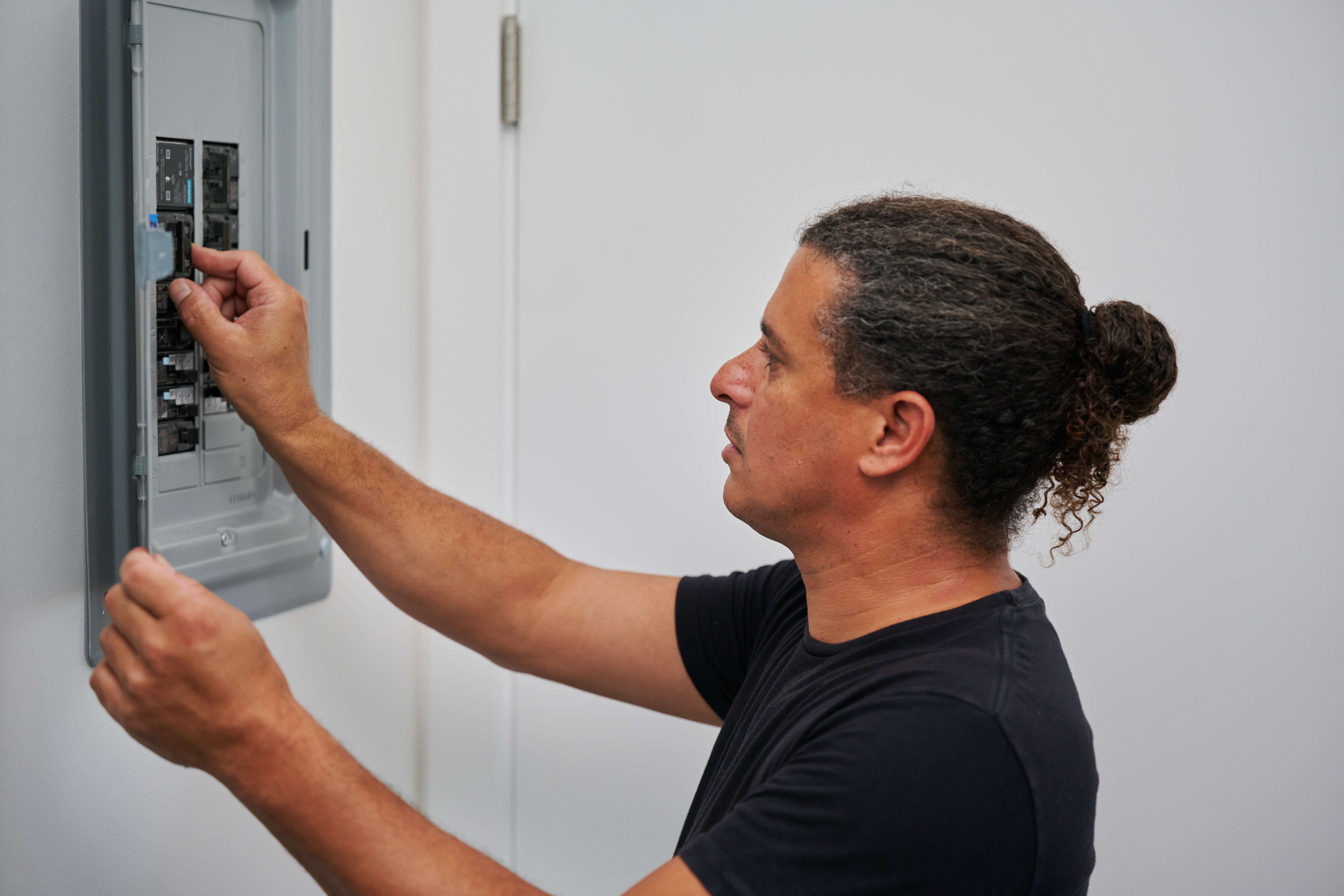
Rewiring a house can be a complex project but don’t let it catch you off guard. Read this to plan ahead and discover the cost to rewire a house.
Dek: The cost to replace outlet averages $200, with most homeowners spending between $150 to $350. Your price depends on outlet type, labor rates, and project complexity.


Replacing an outlet involves removing an old receptacle and installing a new one, ensuring safe and functional power access.
The main cost factors are outlet type, labor rates, and how many outlets you replace at once.
Upgrading outlets—like adding GFCI or smart features—can increase home safety and appeal.
Completing this project can help prevent electrical hazards and keep your home up to code.
For best results, always confirm that your chosen outlet matches your home’s wiring and electrical needs.
This article was created using automation technology and thoroughly fact-checked and edited by an Angi Editor in accordance with our AI policy.
The cost to replace an outlet ranges from $150 to $350 per outlet, with an average cost of $200. Prices depend on the type of outlet, labor rates in your area, and the complexity of the installation. Homeowners can expect to pay per outlet replaced, with additional fees for specialty outlets or challenging locations.
This guide explains what impacts the cost to replace an outlet, so you can make confident decisions and plan your project wisely.
Several factors influence the final cost to replace outlets in your home. Understanding these details will help you set a realistic budget and avoid surprises.
The number of outlets you replace at once has a direct impact on your overall project cost. Replacing a single outlet is straightforward, but replacing several at once may lower the average cost per unit. Electricians often offer bulk pricing for larger projects, making it more cost-effective to update all outlets in a room or throughout your home during one visit.
| Number of Outlets | |||
|---|---|---|---|
| 1 | Single outlet | $100–$250 | $100–$250 |
| 3–6 | One room | $90–$200 | $270–$1,200 |
| 10–20 | Whole home (small/med) | $80–$180 | $800–$3,600 |
| 25+ | Whole home (large) | $75–$170 | $1,875–$4,250 |
The type of outlet you choose significantly affects both material and labor costs. Standard 120-volt outlets are the most affordable, while GFCI (Ground Fault Circuit Interrupter), AFCI (Arc Fault Circuit Interrupter), USB, smart, and specialty outlets cost more due to added features or safety requirements. Tamper-resistant and weatherproof outlets may also carry higher price tags.
| Outlet Type | Description | Cost Per Outlet | Pros | Cons |
|---|---|---|---|---|
| Standard (120V) | Basic indoor outlet | $100–$150 | Affordable, easy to install | Fewer features |
| GFCI | For wet areas (kitchen, bath) | $120–$200 | Improves safety, required by code | Slightly higher cost |
| AFCI | Prevents arc faults | $130–$210 | Fire prevention, code in bedrooms | Higher price, not always required |
| USB | Includes built-in USB charging | $140–$210 | Convenient charging, modern | More expensive, bulkier |
| Smart | App/voice control, automation | $150–$300 | Remote control, energy monitoring | Highest cost, setup required |
| Tamper-resistant | Childproof design | $110–$170 | Safety for families | Slightly more expensive |
| Specialty (240V, etc) | High power, outdoor, floor outlets | $200–$400+ | Handles unique loads or locations | Complex install, highest cost |
Where you live strongly impacts the cost to replace an outlet. Urban areas and high-cost states have higher labor rates, while rural locations may see lower prices. Local building codes and permit requirements can also influence your final bill.
The room or area where the outlet is located can change the price. Outlets in kitchens, bathrooms, garages, and outdoors often require specialty models like GFCI or weatherproof outlets, which cost more. Hard-to-access locations, such as behind cabinetry or on high walls, may add to labor time and fees. Installing outlets in wet areas also means following stricter code requirements, which can raise costs.
Outlet replacement is best handled by licensed electricians, whose expertise ensures safety and code compliance. Labor is commonly billed per outlet or per hour, with minimum service fees ranging from $75 to $150 per visit. Hourly rates range from $60 to $150, depending on your region. Factors like complex wiring, troubleshooting, or replacing old outlets that don’t meet current codes can increase labor time and cost. More experienced or highly licensed electricians may charge a premium for their services, but this often brings peace of mind.
Permit requirements for outlet replacement vary. Simple one-for-one swaps often do not require a permit, but upgrades (like installing GFCI or moving outlets) or work involving new wiring almost always do. Permit fees for electrical work range from $25 to $150. Inspections may be needed for permitted work, especially in areas with strict code enforcement. Skipping required permits can lead to fines or safety issues, so always check with your local building department.
Upgrading to outlets with built-in USB ports, smart features, or tamper resistance will increase the cost to replace an outlet. Surge protection, weatherproof covers, and decorative finishes are other common add-ons that affect pricing. While these features improve safety, convenience, or aesthetics, be prepared for higher material and labor costs.
Manufacturer warranties are often included with new outlets, covering defects for one to five years. Some electricians offer labor warranties, ranging from 30 days to one year. Extended warranties are available for an additional fee but may not be necessary for most homeowners. Warranties can help protect you from unexpected repair costs and add peace of mind.
Most outlets have minimal ongoing operating costs, but smart outlets may use a small amount of standby power. Upgrades can lead to energy savings if you use features like scheduling or energy monitoring. High-quality outlets tend to last longer and require fewer replacements, reducing long-term costs.
Routine inspection and testing—especially for GFCI and AFCI outlets—keeps your home safe. Signs that maintenance is needed include loose outlets, warm surfaces, or tripped breakers. Testing GFCI outlets monthly and scheduling electrical inspections every few years is a smart habit. Proactive replacement of aging outlets can prevent costly repairs or hazards.
Replacing an outlet can be a DIY project for those with electrical knowledge, but it comes with risks and responsibilities.
The main cost savings for DIYers come from avoiding labor charges. Materials for a single standard outlet replacement cost between $5 and $30, while necessary tools (like voltage testers, screwdrivers, and wire strippers) may add $20 to $60 if not already owned. Expect to spend 30 minutes to an hour per outlet, especially if you are new to the process.
However, replacing outlets yourself requires a solid understanding of electrical safety. Hiring a licensed electrician ensures your outlet replacement is safe and code-compliant. Electricians charge an average of $100 to $250 per outlet, which covers labor, materials, and expertise. Minimum service fees may apply for small jobs. The benefits of professional installation include safety, warranty coverage, and reduced risk of future issues.
Deciding between repairing or replacing an outlet depends on the extent of damage, outlet age, and safety. Minor issues, like loose wires or worn screws, can often be repaired. However, outlets with burn marks, persistent tripping, or outdated designs (like non-GFCI in wet areas) should always be replaced. Outlets older than 15 to 20 years are best replaced for safety. If the repair cost approaches 50% of a new outlet install, replacement is the better value. Always consider code requirements and warranty status when deciding.
Repairing an outlet costs $60 to $120, including parts and labor. If the damage is minor and the outlet is relatively new, repair may be cost-effective. But if repair costs near or exceed replacement, or if the outlet is unsafe or outdated, replacement is the smarter long-term choice. New outlets also offer better safety and performance, reducing future problems.
Replacing old or damaged outlets can boost your home’s value, appeal, and safety. Upgrading to GFCI, AFCI, or smart outlets offers a strong return on investment, especially in kitchens, bathrooms, and living spaces. Compared to larger electrical upgrades, outlet replacement is a cost-effective way to improve functionality and meet modern code standards. Enhanced safety is a major selling point for buyers and insurers, while universal design and decorative outlets can make your home more accessible and visually appealing.
Replacing old or damaged outlets can boost your home’s value, appeal, and safety. Upgrading to GFCI, AFCI, or smart outlets offers a strong return on investment, especially in kitchens, bathrooms, and living spaces. Compared to larger electrical upgrades, outlet replacement is a cost-effective way to improve functionality and meet modern code standards. Enhanced safety is a major selling point for buyers and insurers, while universal design and decorative outlets can make your home more accessible and visually appealing.
There are several ways to keep your outlet replacement wallet-friendly without sacrificing quality or safety. Taking these steps can help you save money:
Obtain multiple quotes from local electricians to compare pricing and services.
Choose budget-friendly outlets with proven durability for your home's specific needs.
Bundle your outlet repair with other electrical needs to take advantage of package discounts.
Purchase outlets and materials in advance to avoid markup.
Home is the most important place on earth, which is why Angi has helped more than 150 million homeowners transform their houses into homes they adore. To help homeowners with their next project, Angi provides readers with the most accurate cost data and upholds strict editorial standards. We extensively research project costs to develop the pricing data you see, so you can make the best decisions for you and your home. We rely on reputable sources, including the U.S. Bureau of Labor Statistics, academic journals, market studies, and interviews with industry experts—all to ensure our prices reflect real-world projects.
Want to help us improve our cost data? Send us a recent project quote to [email protected]. Quotes and personal information will not be shared publicly.
From average costs to expert advice, get all the answers you need to get your job done.

Rewiring a house can be a complex project but don’t let it catch you off guard. Read this to plan ahead and discover the cost to rewire a house.

The cost to install a 240-volt outlet varies depending on the amperage and the home’s current wiring conditions. Use this guide to budget for your next project.

Electrical panel replacement costs $530 to $2,100, depending on the location, the type of hardware, and any required building materials.

If your circuit breakers are shutting off, it may be time to upgrade your electrical panel and wiring to 200-amp service. Here's what's involved with upgrading to a 200-amp service so you can safely meet your home's electrical demand.

If you use several electrical appliances in your home simultaneously and the power shuts down, an overloaded circuit could have tripped the breaker. Follow these simple steps to reset your breaker.

GFCI stands for ground fault circuit interrupter. But what is a GFCI outlet, exactly? See how they lower the risk of shock or fire and where to use them.